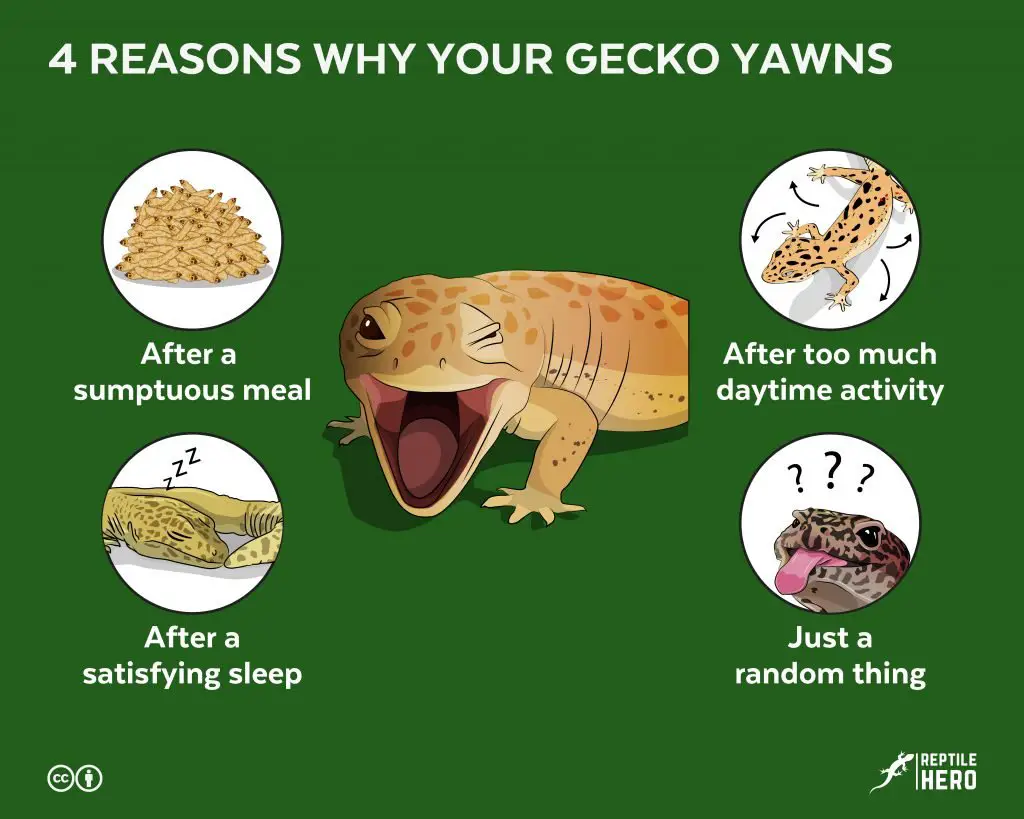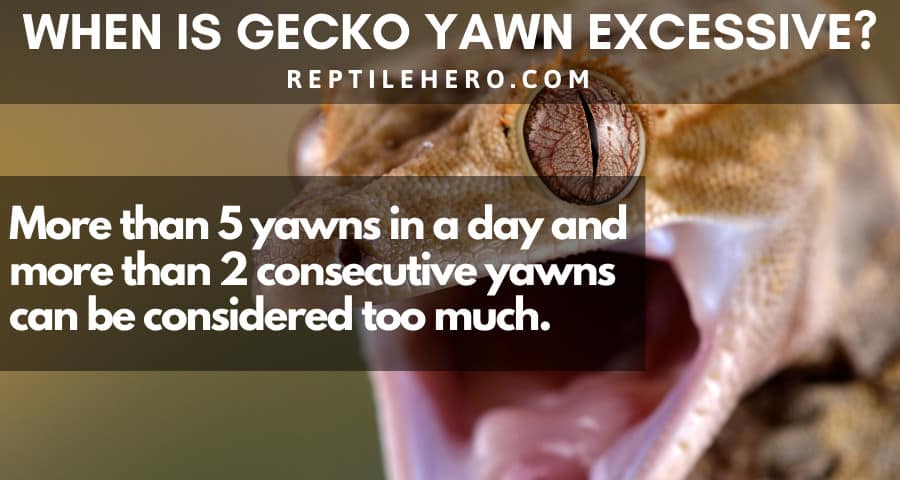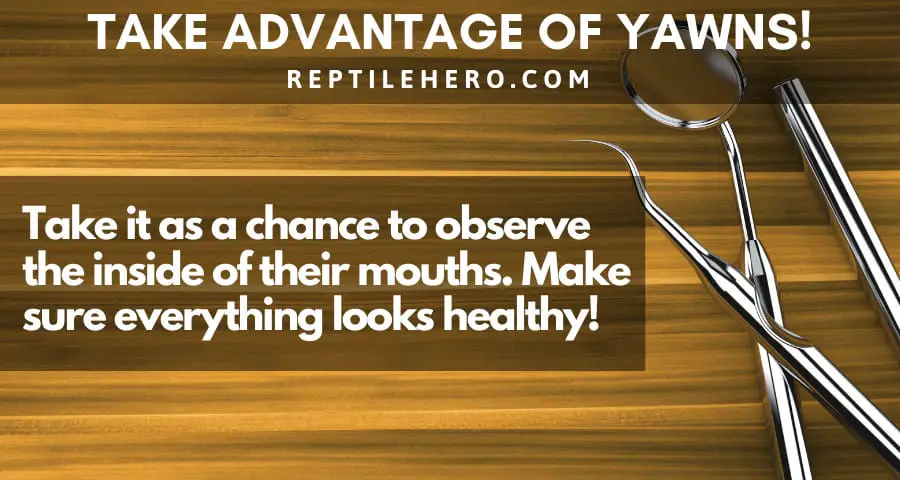Do Leopard and Crested Geckos Yawn?
I bet you saw at least once your leopard or crested gecko in a yawn-like pose. It is too cute, no doubt. So, you might even rush to grab your camera to record it! But is it actually yawing? Is this a sign that it wants to rest? Or are you just overthinking?
Typically, leopard and crested geckos yawn after meals, sleep, or plenty of daytime activities. Other times, geckos do it for no apparent reason. While yawning is harmless most of the time, in some rare cases it can be the underlying symptoms of:
- heat stress
- pathogens
- stuck shed
- stressors
To know when your gecko’s yawning is a concern, stay with us and keep on scrolling.
A little trivia before we move on.
Up to this day, yawning is still not fully understood in humans, and even more in geckos. So, what you read here is the best we can tell on the topic. However, some of the information might be from our knowledge as reptile keepers without any strong scientific proof.
Yawning in Leopard and Crested Geckos
Leopard geckos do open their mouths in a yawning-like action. While crested geckos also exhibit a similar behavior, this is less common than in leopard geckos.
So, you might ask, “What is my gecko actually doing? Is it yawning like we do? How can I differentiate this from another similar action?”
In case you are one of those curious and overly suspicious owners, you would want to be sure that your gecko is yawning and not doing something else. So, according to gecko owners, you could tell that your gecko is yawning when you observe the following:
- The gecko is gaping—opening its mouth really wide.
- The gecko opens its mouth for about three to five seconds.
- This action should be quiet, not accompanied by any sound.
- It usually happens once, although two consecutive times is not uncommon.
- It should make your gecko look relieved and relaxed during and after it happens.
- It should not make your gecko appear anxious, tensed, or startled.
4 Reasons Why Your Gecko Yawns
Gecko owners frequently observe their geckos yawning after a meal, a satisfying sleep, or an extraneous daytime activity. However, other geckos seem to do it at random with no correlation with their activities.

Just like burying, yawning in geckos is commonly noticed as a result of different instances. The following four instances are the cases in which I have observed my geckos doing this:
- After a sumptuous meal: Sometimes, you may notice your gecko let go of a yawn shortly after a palatable food. You just need to make sure that it follows the given guidelines above of what comprises a yawn.
- After a satisfying sleep: When you catch your gecko soon after its long slumber, you could expect it to release a yawn or two. Often, it is simultaneous with its stretching, blinking, and adjusting to a waking state.
- After too much daytime activity: If you have played and taken your gecko out a lot during the day, you might have forgotten that your reptile is crepuscular. So, yawning could be a sign that your gecko is exhausted, and you are better off leaving it alone.
- Just a random thing: There are moments that gecko owners notice their geckos yawn for no clear reason at any time of the day or night. So, you can expect your gecko to do so out of the blue.
When is Yawning in Geckos a Concern? [4 Cases]
Excessive yawning can be a concern that needs the attention of the owner. What is usually taken as excessive yawning is, as a rule of thumb, more than five times a day, keeping in mind that the gecko is well-fed and well-rested.
While occasional yawning in geckos can be typical, excessive yawning can be the bell underlying these four possible issues.
#1. Heat Stress
In tanks with a lack of proper and sufficient temperature gradient, this can cause heat stress to geckos. Its rapid movement from the warm side to the cool side could induce a long or excessive yawn.
So, it is always best to provide your pet a suitable living habitat.
This mouth-opening act, often accompanied by a gular pumping and gular fluttering, is thought to help cool its body faster. Scientists have described this evolutionary behavior as a part of reptilian thermoregulation [1].
#2. Presence of Pathogens
Some pathogens like parasites and viruses can cause gastrointestinal problems, such as reacting negatively to food. Often, they can manifest signs like excessive yawning.
While geckos can survive extreme conditions in nature, this does not mean that they are immune and not vulnerable to pathogens. When this happens, you are best to schedule an appointment with your trusted veterinarian.
#3. Stuck Shed
During the shedding season, geckos may do actions not usually observed by owners in other seasons. Aside from frequent bumping against rough surfaces, another act could be excessive yawning to stretch the skin.
Collectively, these seasonal behaviors could be associated with removing stuck sheds in different parts of their body without your help. So, if you ever see your gecko yawn a lot during shedding time, it is likely that it has a stuck shed on its head or neck area.
#4. Environmental Stressors
Geckos are easily distressed over things and conditions inside the tank. Among other signs like glass surfing and tongue licking, too much yawning could be another manifestation.
As spooky lizards, they could get stressed with poor husbandry—including improper lighting, temperature, and humidity. Even excess feeder insects and too many decorative plants and woods can stress them out and fall sick. As a result, when all other suspected reasons are eliminated, maybe something with your management needs to change.

3 Other Actions Similar to Yawning
One could always dispute that what you have seen was indeed a yawn. So, you should not be alarmed. After all, what looks like a yawn in geckos might be confused with other similar behavior such as choking, vomiting, and defensive stance.
#1. Choking
When a gecko is observed constantly opening and closing its mouth wide enough, it could be choking from its food. Most of the time, you should note this action multiple times in a row—say more than five times—after eating.
The gecko could have had a stuck cricket leg that would not fall down. So, it is trying to dislodge it by persistently flushing it down its throat. Otherwise, it could be working it up to vomit, which leads us to another similar action.
#2. Vomiting
While the gecko is flailing its head, an incessant gaping is the gecko’s attempt to regurgitate the food it has eaten. Just like choking, the mouth wide open looks similar to yawning. Often, it happens after overeating or chewing on sizable feeder insects.
Most of the time, your gecko can resolve this on its own without your intervention. To confirm if it did throw up, you can wait until the act passes by and check its tank for any barf.
#3. Defensive Stance
Opening the mouth wide open might be an indication an aggressive gecko behavior. If this happens when you handle your gecko, you may be better with leaving it for a while until its hostility has subsided.
Yawn-like Action in Other Reptiles
Leopard and crested geckos are not the only ones that show yawn-like behavior. Owners of other reptiles shared with me similar stories as well.
Some commonly kept exotic pets that are noted to yawn or evoke yawn-like actions are [2]:
- Snakes. After preying on a larger animal, they produce a yawn-like motion to readjust and realign their “dislocated” bones and jaw points.
- Iguanas. These lizards may yawn for the same reasons as geckos do. However, some owners say that they see their lizards do it, especially when sneezing.
- Reptiles that eat slime-coated prey. These reptiles could be exhibiting yawn-like actions to clear off their mouths from the slime coating.

Takeaways
Although no studies can explain the action of yawning in leopard and crested geckos (sorry for that), these are commonly and almost daily observed behaviors in my geckos as well as those of other friends of Reptile Hero. They frequently witness it after a sumptuous meal, a satisfying sleep, a lot of daytime activities, or just at random times.
While yawning is seen as a harmless act when there are no other signs present, it can be a manifestation of concerning reasons like heat stress, presence of pathogens, stuck shed, and environmental stressors.
Yawning is often mistaken for other gaping actions like choking, vomiting, and defensive stance. So, it is best to carefully observe the action while it is taking place. In this way, better and more appropriate care would be given.
Sources
[1] https://citeseerx.ist.psu.edu/viewdoc/download?doi=10.1.1.913.4767&rep=rep1&type=pdf

![Do Leopard Geckos Like Blankets? [Best Fabrics]](https://www.reptilehero.com/wp-content/uploads/2021/05/word-image-768x576.png)


![Why Do Leopard Geckos Poop in the Same Spot? [Wild Nature]](https://www.reptilehero.com/wp-content/uploads/2022/03/why-geckos-poop-in-one-spot-cc-1-768x614.jpg)


